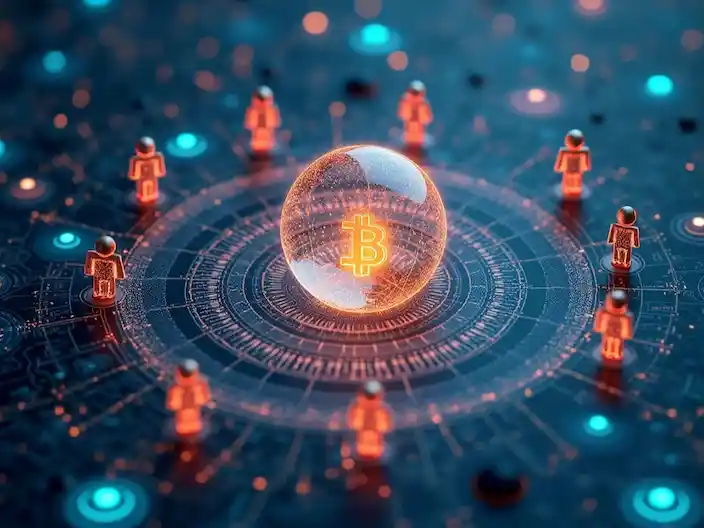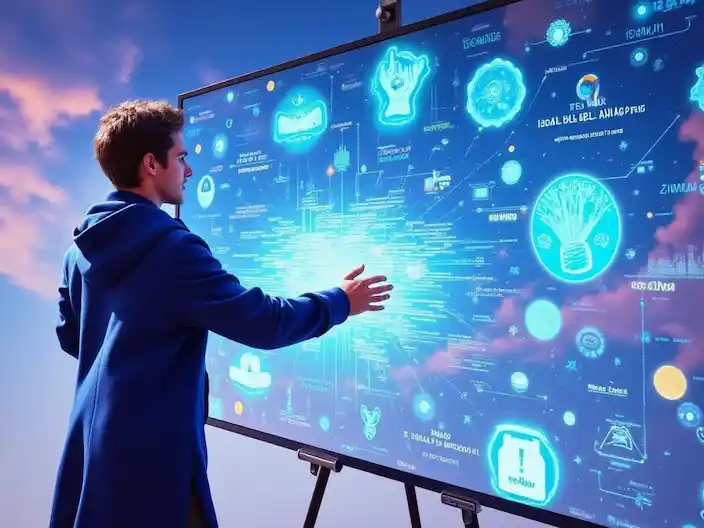Table of Contents
- Introduction
- Advantages and Challenges of the Self-Organizing Metaverse
-
- Increased Productivity and Scalability
-
- Reduced Operational Costs
-
- Improved Security and Privacy
-
- Efficient and Decentralized Digital Economy
-
- Optimized Social Interactions and Dynamic User Experience
-
- Security Issues and Cyberattacks
-
- Dependence on Powerful Computational Infrastructure
-
- Ethical and Legal Issues
-
- Public Adoption and Social Acceptance
-
- Future Outlook of the Self-Organizing Metaverse
- Suggested Solutions for Implementing the Self-Organizing Metaverse
-
- Use of Neural Networks and Machine Learning for Autonomous Metaverse Management
-
- Blockchain and Smart Contracts Development for Decentralized Metaverse Management
-
- Creation of Powerful and Scalable Computational Infrastructures
-
- Setting Legal and Regulatory Frameworks for Autonomous Metaverse
-
- Development of AI-Based Social Interaction Systems and Autonomous Metaverse
-
- Increasing Awareness and Public Adoption of the Self-Organizing Metaverse
- Conclusion
-
- Future Path of the Self-Organizing Metaverse
-
- Key Takeaways of the Paper
-
- Future of the Self-Organizing Metaverse
-
- Suggested Path for Developing the Self-Organizing Metaverse
-
- Final Conclusion
Introduction
In the first part of this article, the necessity of autonomous systems and the impact of technologies like AI and blockchain in shaping a self-organizing metaverse were discussed. In this section, we will delve deeper into these concepts and explore their application in the digital world. Particularly, the relationship between the features of the metaverse and autonomous systems, as well as how a dynamic, self-managing digital space can be created, are key themes of this section. Autonomous systems, with their ability to learn, make independent decisions, and adapt, provide the foundation for scalable and optimized metaverse management. These systems, using advanced algorithms and intelligent interactions, could play a pivotal role in governing and developing future metaverses.
In this part, we will analyze the applications of autonomous systems in the metaverse and examine how AI, intelligent digital agents, and blockchain can efficiently manage and optimize this space without human intervention. Therefore, the future of the self-organizing metaverse, with features such as automated security, optimized interactions, and decentralized sustainability, is moving towards significant transformations.
Advantages and Challenges of the Self-Organizing Metaverse
The self-organizing metaverse, by leveraging AI, blockchain, machine learning, and autonomous systems, is capable of managing and optimizing its environment without human intervention. This characteristic helps create a sustainable, decentralized, and intelligent digital ecosystem. However, developing these systems comes with various advantages and challenges that must be addressed for their success.
The self-organizing metaverse has characteristics that differentiate it from other digital systems. Some of the most important advantages include:
-
Increased Productivity and Scalability
✅ Intelligent Resource Management: Autonomous systems can optimize computational resources and bandwidth usage, enabling the processing of massive data volumes at a large scale.
✅ Automated User Interactions: AI can analyze user behavior and personalize interactions based on their needs.
✅ Optimized Data Traffic: Machine learning networks can reduce data transfer volumes and optimize processing times. -
Reduced Operational Costs
✅ Reduced Labor Requirements: Many managerial, computational, and analytical tasks can be automated, reducing the need for human staff.
✅ Automated Transactions: Smart contracts based on blockchain can perform many financial and economic processes without intermediaries.
✅ Optimized Infrastructures: Autonomous algorithms can manage hardware and software resources, reducing computational costs.

-
Improved Security and Privacy
✅ Advanced Encryption: The use of blockchain and modern encryption methods enhances data security and prevents hacking attempts.
✅ Intelligent Cybersecurity Management: Digital agents can identify cyber threats and automatically take necessary security actions.
✅ Personal Data Control: AI can manage user privacy by filtering sensitive information and setting access permissions for data. -
Efficient and Decentralized Digital Economy
✅ Intelligent Digital Asset Management: Autonomous agents can determine the value of digital assets based on machine learning algorithms.
✅ Development of Fast and Secure Payment Systems: The use of decentralized digital currencies and smart contracts can create an efficient and scalable economic system within the metaverse.
✅ Reduced Fraud and Scams: Blockchain and machine learning can identify fraudulent transactions and suspicious activities, preventing financial fraud. -
Optimized Social Interactions and Dynamic User Experience
✅ Intelligent Social Management: Autonomous systems can optimize the social space of the metaverse, creating environments based on users’ interests and needs.
✅ Support for International Communication: Real-time translation and sentiment analysis facilitate international communication within the metaverse.
✅ Improved User Experience: Dynamic digital environments can automatically adapt to provide more engaging and realistic interactions.
Despite these benefits, the development and implementation of the self-organizing metaverse face multiple challenges that need to be managed.
-
Security Issues and Cyberattacks
⚠️ Targeting Autonomous Systems: Hackers could manipulate machine learning algorithms and influence autonomous decisions within the metaverse.
⚠️ AI-Based Attacks: Malicious digital agents could spread throughout the metaverse, carrying out phishing attacks, identity theft, or intrusions into user assets.
⚠️ Violation of User Privacy: Machine learning systems might over-analyze user data, potentially creating serious privacy issues. -
Dependence on Powerful Computational Infrastructure
⚠️ Need for Advanced Servers and Powerful Processors: Processing massive data volumes in the metaverse requires robust computational infrastructures and high-speed communication networks like 6G.
⚠️ High Energy Consumption: AI and blockchain-based systems may have high energy demands, requiring ongoing optimization.
⚠️ Global Accessibility Challenges: Many users in developing countries lack access to the necessary infrastructure for engaging with the metaverse. -
Ethical and Legal Issues
⚠️ Regulations for Autonomous Agents: The legal frameworks for controlling and holding digital agents accountable have yet to be properly defined.
⚠️ Issues with Digital Property Rights: Without clear legal frameworks, digital asset ownership within the metaverse might face serious challenges.
⚠️ Content and User Interaction Monitoring: Balancing free speech with content control is one of the main challenges of the self-organizing metaverse. -
Public Adoption and Social Acceptance
⚠️ Lack of Trust in Autonomous Systems: Some users may be skeptical about whether autonomous systems can make fair decisions.
⚠️ Cultural and Social Challenges: While the metaverse is a global ecosystem, it may present acceptance challenges for users from different cultural backgrounds.
⚠️ Resistance from Traditional Industries: Many traditional companies may resist the transition to a digital, decentralized economic environment.

-
Future Outlook of the Self-Organizing Metaverse
✅ The self-organizing metaverse could address many current limitations of the internet and the digital world, offering an intelligent, scalable, and decentralized environment.
✅ However, for this technology to succeed, security, legal, ethical, and infrastructural challenges must be properly managed.
✅ AI, blockchain, and machine learning will play key roles in the development of the self-organizing metaverse.
Suggested Solutions for Implementing the Self-Organizing Metaverse
To achieve a self-organizing and intelligent metaverse, a combination of advanced technologies like AI, machine learning, blockchain, IoT, cloud computing, and decentralized networks is required. This section presents proposed solutions to optimize performance, increase security, improve user experience, and address challenges within the self-organizing metaverse.
-
Use of Neural Networks and Machine Learning for Autonomous Metaverse Management
- Intelligent Decision-Making Systems for Automatic Regulation of Metaverse Rules and Environments
✅ Reinforcement Learning Implementation: Machine learning can execute dynamic decision-making algorithms to adapt rules and environments within the metaverse based on real-time data.
✅ Creating Smart Learning Agents: These agents can make independent decisions and optimize themselves based on past experiences.
✅ Sentiment Analysis for Optimizing Social Interactions: AI can analyze user behavior and create personalized interactive environments. - Development of Predictive Models to Optimize Resources and Data Traffic
✅ User Behavior Prediction: Machine learning models can predict how users interact with the environment, optimizing their experience.
✅ Intelligent Management of Traffic and Energy Consumption: Smart algorithms can adjust computational resource use and reduce processing costs.
- Intelligent Decision-Making Systems for Automatic Regulation of Metaverse Rules and Environments
-
Blockchain and Smart Contracts Development for Decentralized Metaverse Management
- Creation of a Decentralized and Autonomous Economy
✅ Creating Autonomous Markets Based on Smart Contracts: These markets can set prices without intermediaries based on user demand.
✅ Automated Financial Transactions: Blockchain can make financial processes secure, transparent, and decentralized.
✅ Token-Based Income Distribution Models and NFTs: Users can earn through the digital economy and manage their assets within decentralized environments. - Increasing Security and Preventing Fraud
✅ Decentralized Identity Verification (DID): Users can have a secure and controlled digital identity.
✅ Anti-Fraud Algorithms: AI can identify fraud patterns and cyber-attacks, enhancing network security.
✅ Implementing Decentralized Voting Systems for Collective Decision-Making: Users can participate in key decisions within the metaverse.
- Creation of a Decentralized and Autonomous Economy
-
Creating Powerful and Scalable Computational Infrastructure
- Using Cloud Computing and Edge Computing
✅ Increasing computational efficiency: Combining cloud computing and edge computing can reduce data processing time and make the Metaverse scalable.
✅ Distributed server load management: Data can be distributed based on usage across different points in the network to optimize performance
- Implementing High-Speed Communication Protocols (6G and Satellite Internet)
✅ Reducing latency in Metaverse communications: The use of 6G internet and satellite networks can reduce the latency in processing Metaverse data.
✅ Increasing bandwidth for global users: These technologies provide fast and unrestricted access to the Metaverse for users around the world.
-
Setting Legal Regulations and Frameworks for Autonomous Metaverse
- Defining Legal Standards for Digital Ownership and Smart Contracts
✅ Creating international laws for digital ownership: Countries need to develop clear legal frameworks for the ownership of virtual land and digital assets.
✅ Clarifying user rights: It should be made clear how user rights will be protected in decentralized environments.
- Establishing Regulatory Measures to Control Illegal Activities
✅ Preventing money laundering and fraud: Regulatory bodies can use machine learning algorithms to identify suspicious activities.
✅ Developing automated algorithms for content review and user interactions: Illegal content can be automatically detected and removed.

-
Developing AI-based Social Interaction Systems and Autonomous Metaverse
- Using Digital Agents to Improve Social Interactions
✅ Creating advanced chatbots to guide users: These agents can automatically answer user questions and guide them within Metaverse environments.
✅ Managing virtual communities with intelligent agents: Autonomous systems can monitor user interactions and prevent disruptive behavior.
- Personalizing Metaverse Environments for a Better User Experience
✅ Creating augmented reality systems to adapt environments to users: Metaverse environments can change based on users’ behavior and needs.
✅ Analyzing social interactions for better recommendations: AI systems can suggest suitable locations, activities, and events for each user.
-
Increasing Public Awareness and Acceptance of the Self-Organizing Metaverse
- Educating Users about Interactions in the Autonomous Metaverse
✅ Creating training courses about security and privacy in the Metaverse
✅ Educating developers about decentralized and autonomous system architecture
- Promoting Collaboration between Public and Private Sectors
✅ Investing in Metaverse-related research and autonomous systems
✅ Creating supportive policies for the development of the self-organizing Metaverse
- The Future Path of the Self-Organizing Metaverse
🔹 By combining AI, blockchain, and machine learning, the Metaverse can evolve into a smart and decentralized ecosystem.
🔹 Implementing advanced processing networks and developing legal standards will play a key role in the success of these systems.
🔹 Optimizing social interactions and creating a self-sustaining economy can facilitate the public’s acceptance of the Metaverse.

Conclusion
-
Future Path of the Self-Organizing Metaverse
The Metaverse, as the next generation of the internet and digital interactions, is becoming a complex, scalable, and autonomous ecosystem where users can live, work, and trade in decentralized virtual spaces. However, challenges in management, security, scalability, and social interactions in this environment have created an increasing need for autonomous and intelligent systems.
In this article, the concept of the self-organizing Metaverse as a digital space based on intelligent agents and autonomous algorithms was explored. Given the traditional challenges in managing centralized Metaverses, the use of AI, blockchain, machine learning, IoT, and cloud computing technologies can make the development of a secure, autonomous, and sustainable Metaverse possible.
-
Key Takeaways from the Article
- Role of Autonomous Systems in Metaverse Development
🔹 Digital agents and intelligent systems can make autonomous and adaptive decisions in the Metaverse without human intervention.
🔹 Digital asset management, smart contract execution, and resource optimization can be facilitated by blockchain and AI.
🔹 Social interactions and user experience in the Metaverse can be enhanced with intelligent agents, creating a fully personalized and interactive environment.
- Key Benefits of the Self-Organizing Metaverse
✅ Reducing management and processing costs: Automating processes increases productivity and reduces operational costs.
✅ Increasing security and preventing fraud: AI and blockchain technologies can enhance cybersecurity and prevent digital fraud.
✅ Creating a decentralized and sustainable economy: Through smart contracts and digital tokens, the Metaverse can be managed without central institutions.
- Key Challenges in Implementation
⚠️ Security challenges: Cyberattacks on autonomous systems could jeopardize user data security.
⚠️ Legal and governance issues: Legal standards for managing digital ownership and the accountability of intelligent agents are yet to be fully developed.
⚠️ Infrastructure limitations: Developing the self-organizing Metaverse requires significant investment in communication networks, cloud processing, and high-speed internet (6G).

-
The Future of the Self-Organizing Metaverse
Given technological advancements and the increasing demand for dynamic and scalable digital environments, the Metaverse will move towards autonomy and decentralization in the coming years. Some of the most important future developments include:
- The evolution of AI and machine learning in the Metaverse
🔹 Advanced intelligent agents capable of managing user assets, monitoring security, and providing smart recommendations.
🔹 Sentiment analysis and user interactions to make Metaverse environments more optimized and interactive.
- Integration of blockchain and digital economy in the Metaverse
🔹 Fully decentralized digital ownership, where users manage virtual property and assets without traditional intermediaries.
🔹 Development of smart markets managed by self-executing contracts (Smart Contracts).
- Implementing next-generation computational and communication infrastructure
🔹 Using 6G internet and advanced communication technologies to reduce latency and enhance user experience in the Metaverse.
🔹 Distributed cloud processing for sustainable data management in decentralized environments.
- International Laws and Regulations for the Autonomous Metaverse
🔹 Creating legal frameworks to regulate digital markets, social interactions, and data security.
🔹 Adopting global standards to define the role and responsibility of AI and autonomous systems in the Metaverse.
- Suggested Path for Developing the Self-Organizing Metaverse
🔸 Research and development in AI and autonomous agents: Increasing investment in machine learning algorithms, natural language processing (NLP), and intelligent decision-making systems.
🔸 Developing stronger security protocols: Using encryption algorithms and decentralized authentication to protect users’ data and assets.
🔸 Developing scalable technologies for cloud processing: Leveraging cloud computing and edge computing to reduce latency in the Metaverse.
🔸 Increasing public awareness and social acceptance: Organizing educational courses for users, developers, and policymakers on the self-organizing Metaverse.
🔸 Collaboration between governments, companies, and universities: Creating joint research platforms to develop the self-organizing Metaverse, draft laws, and raise global standards.
-
Final Conclusion
The self-organizing Metaverse will create a significant transformation in the structure of the internet and the digital world. Relying on intelligent agents, blockchain, and machine learning, this system will provide a decentralized, secure, and intelligent environment.
🔹 This transformation will not only revolutionize the digital economy but also create new models of social interactions, businesses, and digital life.
🔹 To achieve this vision, security, infrastructure, and legal challenges must be overcome, and appropriate global standards must be set to regulate autonomous systems.
🔹 Global cooperation between technology companies, governments, and researchers will play a crucial role in the development of a self-organizing and sustainable Metaverse.
In the end, the Metaverse of the future will not just be a digital space but an intelligent ecosystem capable of self-managing, optimizing, and expanding. This transformation will be a crucial step towards a future where AI and decentralized technologies will elevate the digital world beyond today’s imagination.
Table of Contents
Toggle


One Response